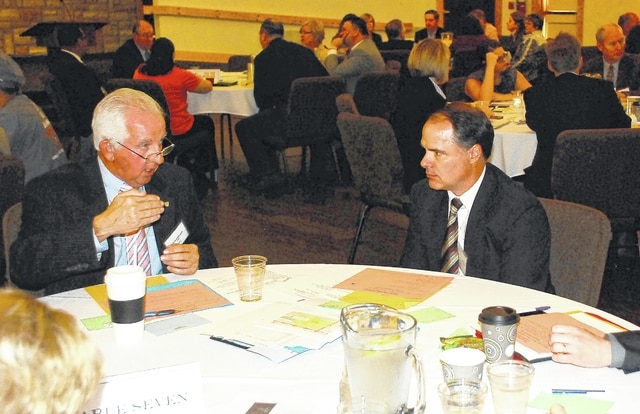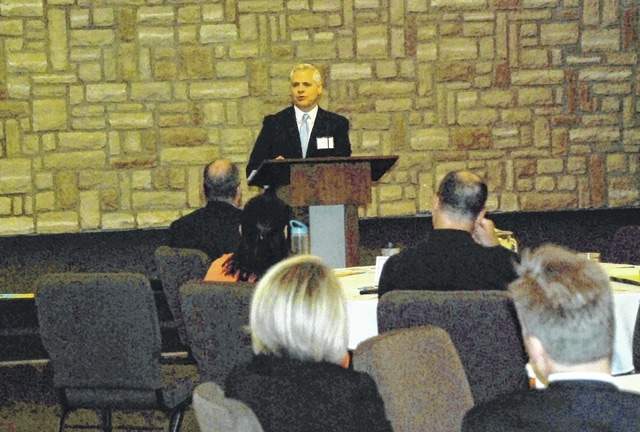

Over 50 area leaders in the health care, business and education sectors gathered on Wednesday for Community Mercy Health Partners’ Healthcare Summit: A Community Conversation of Clark & Champaign County.
The summit, held at the Urbana Christian Conference Center, 1778 W. state Route 29 near Urbana, was organized to find out which issues local leaders see as the biggest threats to the overall health of area residents and what can be done to make Champaign and Clark counties healthier.
In order to gather the data, those participating in the summit were placed randomly at one of nine tables and moderator Dave Estrop, former superintendent of Springfield City Schools, asked the groups to answer the following questions:
•What are the top five health care issues in Champaign and Clark counties?
•What are the five things we should do to address the identified health care issues?
Each group was asked to come up with answers using the consensus decision-making process, which Estrop said involves group members agreeing on answers everyone at the table could “support and live with seven out of 10 times,” instead of having each individual vote for his or her top answers.
“One of the beauties of a group this big and diverse is … diversity in … opinions and a lot of knowledge from different perspectives,” Estrop said. “We want to take advantage of that.”
The biggest health care issue facing Champaign and Clark counties, according to seven of the nine groups, is access to care.
Concerns over a lack of prevention services (six of nine) and drug addiction (six of nine) tied for the second biggest health care issue. Rounding out the rest of the top five were rising healthcare costs (five of nine) and access to behavioral or mental health services (five of nine).
When asked to list five actions that can be done to address the identified health care issues, all nine groups agreed collaboration among everyone in the community is key, while seven of the nine groups felt taking health care services to people via mobile and after-hours clinics is needed.
The rest of the top five included the following possible solutions to health care issues affecting Champaign and Clark counties: developing a partnership with the education sector to educate youths on healthy living (four of nine), recruiting more health care professionals (four of nine), and better communication among everyone in the community (three of five), which tied with the desire to align physician incentives with what the community wants and expects from its health care providers (three of five).
“The issues that each group prioritized were not surprising,” said summit organizer Marianne Potina, vice president of mission integration for Community Mercy Health Partners. “What was most encouraging was the insightful list of action steps we should consider to address these issues, especially the number one suggestion of collaboration. That tells me that as a community, we recognize we are all accountable.”
Potina added that based on the initial feedback she received from the participants, the health care summit was a success.
“More importantly, I believe the written commitment of the majority of participants to be involved on a task force spoke volumes,” she said. “Putting the ideas into actionable outcomes is paramount to improve the health of our communities.”
Health care employment
Jon Fishpaw, vice president of advocacy and government relations for Mercy Health, discussed growth being seen not only at the state level, but also nationally in terms of the amount of jobs in the health care sector.
Fishpaw stated that a recent report released by the American Hospital Association claims that direct employment by hospitals across the country is 5.5 million.
“It’s the second largest source of private sector jobs in the county,” he said, adding that hospitals support one in nine U.S. jobs through direct and indirect employment.
Fishpaw said health care jobs in Ohio have been on a steady rise over the past 20 years.
“In 1995, there were no health systems ranked as a top 10 employer,” he said. “Today, things are a little different. Of the top 12 employers today in Ohio, six of them are health systems.”
He said Mercy Health is the fourth-largest employer in the state with 33,000 employees system-wide. Only the Cleveland Clinic employs more Ohioans in the health care sector than Mercy Health.



